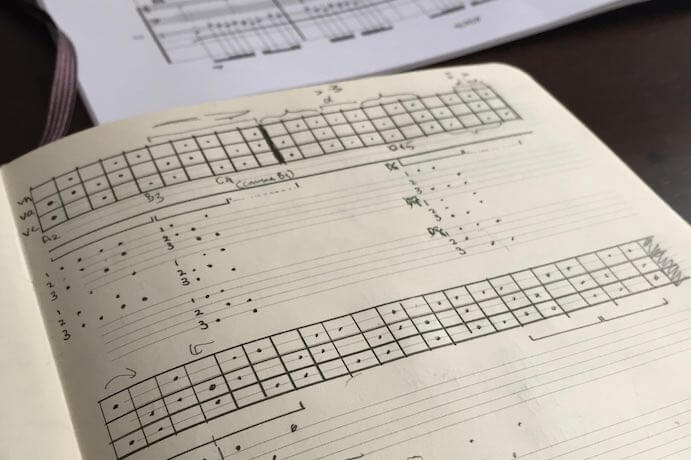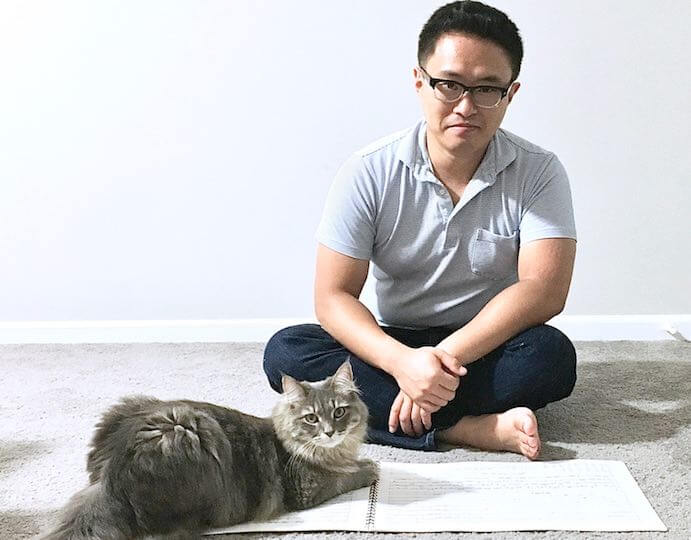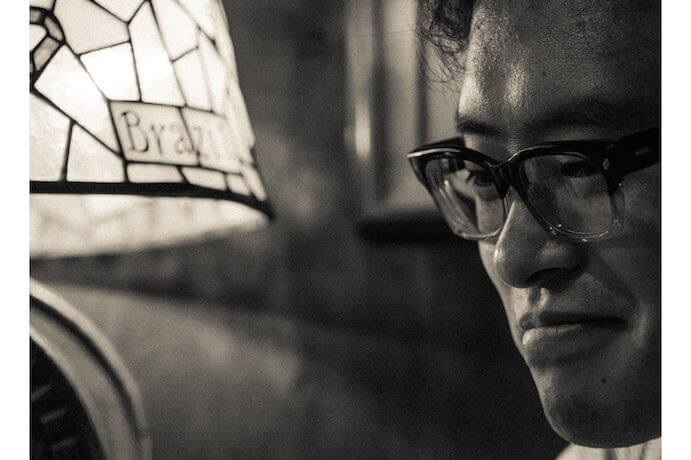Recipient of the 2018 Guggenheim Fellowship, Yoshiaki Onishi is a Japanese-American composer and conductor, who will be a postdoctoral fellow at the Mizzou New Music Initiative beginning in Fall 2018. (See here for a list of his many commissions and premieres.) One of the most fascinating aspects of Onishi’s compositions is his approach to music as the circulation of ideas—how each musical work has an underlying idea or concept that shapes the compositional process and the sound at each moment. Related to this is the tactility of the sound—Onishi’s great virtuosity in employing contemporary techniques and his attention to the physical properties of sound. Both features are especially evident in his ongoing project Les Six Aspects du Néant (“The Six Aspects of Nothingness”), a cycle of six pieces for string quartet. Parts of the cycle will receive performances this coming Fall at the Vertixe Sonora Festival in Spain, the 45th International Viola Congress in Rotterdam, and the Trieste Prima Festival in Italy.
My understanding of genre is that it’s not some fixed category, but rather results from its continual use and reproduction. What draws you to the string quartet as a genre?
If I were to name one piece that was the critical turning point for my current compositional aesthetics, I’d have to say it is my Culs-de-sac (en passacaille) (2009, revised in 2010) for string quartet. I think that the string quartet as a genre motivated me to discover what it means to truly listen when I compose. Technically speaking, the string quartet is very highly refined and uniform in terms of the overall timbre, composed of four instruments of the same instrumental family. So it poses a different type of challenge than, for example, writing for orchestra where there are readily more varied timbral possibilities at the composer’s disposal. As I wrote Culs-de-sac (en passacaille), I became interested in excavating what lies beneath the surface level—this surface level being the timbral uniformity of the string quartet. As a result, listening for me became an obsessive act, focusing myself on the process of listening to the sounds at a deeper level.
Initially, writing a cycle of pieces was not in my mind. Then in mid-to-late 2010, I came across the recording of Quatuor Diotima playing Liturgia Fractal by Spanish composer Alberto Posadas, then another recording of the Arditti Quartet playing the cycle Zayin by Francisco Guerrero Marín, teacher of Posadas. Listening to these pieces, I thought that writing a cycle would be a good idea for me, as well. But since every work would be conceived as an individual piece that would or would not be played as part of the cycle, I decided that in my cycle, all four players only play three out of the six pieces. I thought that working on subset formations gives me an opportunity to re-examine timbral constituents of the string quartet. But in order to ensure the thematic cohesion of the cycle across different instrumentation, I decided that I would embed the musical elements of Culs-de-sac (en passacaille) in the other pieces in the cycle—for example, I ask all the strings to detune, and this scordatura is kept throughout the cycle.
You translate your cycle’s title, Les Six Aspects du Néant as “The Six Aspects of Nothingness.” How does your understanding of “néant” shape your compositional process and the sound of each piece in the cycle?
The term Néant could have been “nothingness,” “das Nichts,” “mu,” or however one may say it in whatever the language. It’s a concept ubiquitous in our lives yet how we understand and explain it differs from one person to another. “Nothingness” is also a concept that I’ve dealt with over the years, and in the span of slightly less than a decade of working on this cycle, my perspective on it became deepened as I experienced more in my life. So in a way it chronicles, in neither a hierarchical nor a culturally privileging manner, the results of my ways of perceiving the concept of nothingness.
Furthermore, Néant is to me a motto for myself when I compose, as much as it is a title of the cycle. It initially comes from my experience of writing Culs-de-sac (en passacaille). The process of writing the piece began, in the psychoanalytical sense, by emptying my mind so as to let the anxieties go and my mind be in the state of nothingness, at least the virtual one. By doing this, the action of writing notes is equated with the action of listening. I should also mention that my composition teacher at the time was Fabien Lévy, who spoke very often of the composers being the first audiences of their pieces, and I now realize that I was confirming what he said through my own experience.
Tr (épilogue) for violoncello solo (2012, revised in 2014) deals with, among other things, transitional sounds hovering around, out of and into nothingness. Parti… for violin solo (2012-14, revised in 2015) has a similar approach to sounds as the cello solo piece, but the notion of counterpoint plays a key role in weaving the constellation of timbres together. Envoi II for string trio (2016) deals with the idea of nothingness on a more psychological and existential level than the compositional level, which is the idea of void brought upon by a permanent, irrevocable loss. When I was starting to write the string trio, I learned the passing of a friend of mine and a formidable percussionist, James Deitz, and I sensed a void in my mind, which could only be reconciled by the act of remembrance. I don’t think there is anything sentimental about that string trio, but as my dissertation advisor at Columbia, George Lewis, remarked about how rhythmical the piece is, it might have been my way to reimagine my late friend’s presence.
At the moment, I’ve completed four out of the six pieces. I’m currently working on the solo viola piece for Anna Pelczer, and the violin duo piece is an upcoming project.

Sketch of Yoshiaki Onishi’s Envoi II
Could you elaborate on your attention to the tactility of the sound?
I certainly think about tactility of sound a lot, and for that I admit that the music and writings of Helmut Lachenmann, and of some of his students, e.g. Mark Andre, Pierluigi Billone and others, were influential to me. But as an active listener, I find myself being unable to think about it on its own; instead, I very often think of it in the context of time (e.g., how might I trace a path of time in order to let the grainy and sharp sound morph into something less astringent?). I listen to, and compose, music in a structural manner—the music is a temporal space consisting of relationships between different types (i.e. qualities) of sound.
I also think about how listening into a sound for a prolonged period of time can affect the way I may qualify the sonic tactility. There is one section in Tr (épilogue) where I wanted to explore the sound of the cellist applying a very strong bow pressure against the string, yet playing it quietly. This goes on for a minute or so, and I have always found it interesting to listen to this section and notice, after that minute, the perforated sound seems to have a liquid-like fluidity.
How does your collaboration with specific performers and ensembles shape your compositional process?
For me, composition is a dialogic process, where the performers play a key role in providing feedback, which could further refine my core ideas for my piece. I was fully awakened to this notion as I was writing Tr (épilogue) for violoncello solo in 2012, while I was participating in the Creative Dialogue in Santa Fe, New Mexico, an initiative founded by Finnish cellist Anssi Karttunen. For five or six days, I wrote in the morning, then in the afternoon I worked closely with the cellist Patrick McGuire, while receiving feedback from him and Karttunen, and sometimes the composer-in-residence Magnus Lindberg. From this experience, I distanced myself further from the idea that composers can just pick out sounds from out of nowhere. It became evident that their feedback ultimately helped me reach the sound I want to hear in my music.

Yoshiaki Onishi
How do you incorporate the notion of music as the circulation of ideas into your composing?
Nothingness—the central idea or theme of Les Six Aspects du Néant—is very open to multiple readings. Much like I see composition as a dialogic process with the performers, the same is true for the listeners. By using ideas that are open—their meaning can’t be determined in advance—I encourage the active participation of the listeners. As a composer, I’m not interested in delivering a specific message—if such a thing is even possible. Rather, it’s the open-ended process where the listener also creates meaning that I find most rewarding.























